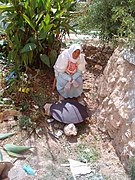Markook (bread)
This article includes a list of references, related reading, or external links, but its sources remain unclear because it lacks inline citations. (August 2018) |
 | |
| Alternative names | Shrak, ruqaq, rqeeq, or mashrooh |
|---|---|
| Type | Flatbread |
| Place of origin | Middle East |
| Region or state | Levant, and Arabian Peninsula |
Markook bread (Arabic: خبز مرقوق, romanized: khubz marqūq), also known as khubz ruqaq (Arabic: رقاق), shrak (Arabic: شراك), khubz rqeeq (Arabic: رقيق),[1][better source needed] mashrooh (Arabic: مشروح), and saj bread (Arabic: خبز صاج), is a kind of Middle Eastern unleavened flatbread common in the Levant and the Arabian Peninsula. It is baked on a convex metal griddle (a saj) or in a tannour.
Markook shrak is a type of thin bread. The dough is unleavened and usually made with only flour, water, and salt, and after being rested and divided into round portions, flattened and spread across a round cushion until it is thin then flipped onto the saj.[2] It is often folded and put in bags before being sold.
It is commonly compared to pita bread, also found in Middle Eastern cuisine, although it is much larger and thinner. In some Arab countries, such as Yemen, different names are given for the same flatbread, such as khamir, maluj and ṣaluf, depending on the regional dialects. By Israelis, markook may also be referred to as laffa, though markook and laffa are distinct types of flatbread.
Etymology
[edit]Markook (مرقوق) comes from the Arabic word raqiq (رقيق) meaning delicate, and raqiq also comes from the verb Raq (رق).[3]
History
[edit]Markook was also mentioned in the tenth-century cookbook of Ibn Sayyar al-Warraq under the name ruqaq.[4] He describes it as large and paper-thin, unleavened bread.[4]
German orientalist Gustaf Dalman described the markook in Palestine during the early 20th-century as being also the name applied to flatbread made in a tannour, although, in this case, it was sometimes made with leavening agents.[5]
Gallery
[edit]-
Markouk prepared by Syrian Jews in Jerusalem
-
Markouk being prepared and cooked on a saj
See also
[edit]- Chapati
- Gözleme
- Lavash
- Khubz
- Naan
- Pita
- Piadina
- Pane carasau
- Rumali Roti
- Yufka, another bread called "saj bread"
References
[edit]- ^ "طريقة عمل خبز رقاق - موضوع". موضوع (in Arabic). Retrieved 2018-11-27.
- ^ Elamine, Anthony Morano and Leila. "Rima's Saj Bread Film |The Recipe Hunters in Lebanon". The Recipe Hunters. Retrieved 2018-11-27.
- ^ "مرقوق".
- ^ a b Ibn Sayyar, Al-Warraq; Nasrallah, Nawal (26 November 2007). Annals of the Caliphs' Kitchens: Ibn Sayyar Al-Warraq's Tenth-Century Baghdadi Cookbook. Brill Academic Publishers. p. 568.
- ^ Dalman, Gustaf (1964). Arbeit und Sitte in Palästina (in German). Vol. 4 (Bread, oil and wine). Hildesheim. OCLC 312676221.
{{cite book}}: CS1 maint: location missing publisher (link) (reprinted from 1935 edition), Photographic illustration no. 30 [Dreizehn Brotarten (Thirteen bread types)]
- ""A Fork on the Road" - Miami Herald online". Miami Herald. Retrieved February 21, 2008.[dead link]
- ""Saj Femmes" - Blog: Land and People". 23 September 2007. Retrieved February 21, 2008.




